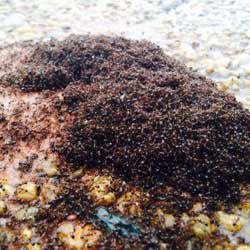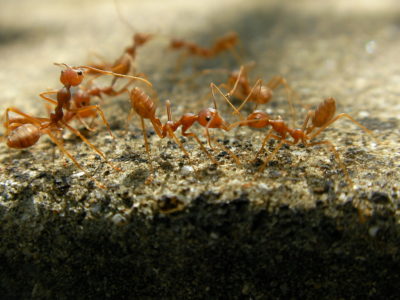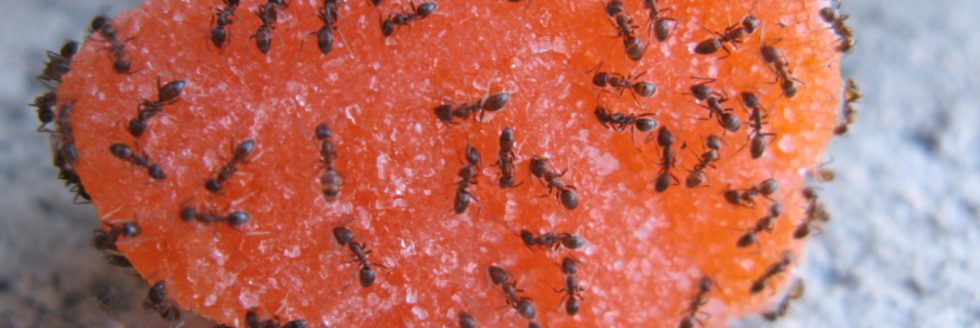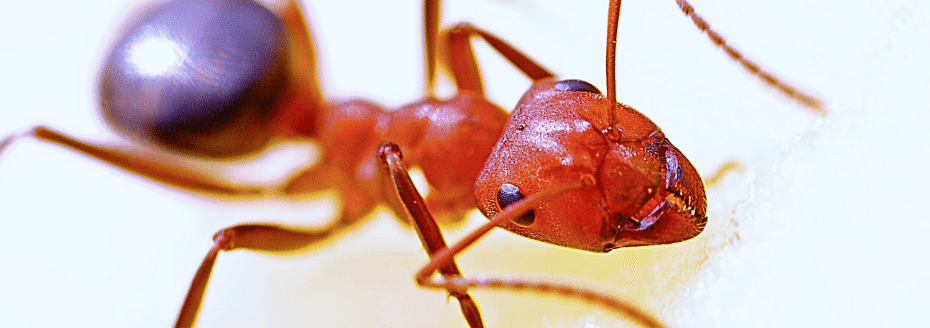Top 10 Things to Know About Fire Ants
Fire ants are more than a nuisance to residents in the Carolinas. The bugs can attack members of your family and leave behind painful bites. Although most bites are not fatal, serious complications can occur. As red fire ants continue to spread across the Carolinas due to favorable weather conditions, homeowners must remain vigilant about protecting their properties from fire ant invasions.
Carolina Pest Management is available to help rid your property of invasive fire ants with stinging insect control services. Our expert team advises all locals to know these top ten facts about fire ants. These facts will assist with identifying fire ants and understanding the best course of action to eliminate the pests from your property for good.
1. Signs of Fire Ant Infestations
The first part of checking for an infestation is identifying the fire ant. Fire ants have a reddish-brown color with visible antennae. They range in size from 1/8” to 3/8.” If you do see any fire ants, they are most likely either swarmers or workers. Queens are winged insects and mate in flight. In many cases, individuals identify a mound before seeing a fire ant.
Mounds are prominent in size and can reach up to 24 inches high in ideal soil conditions. Mounds are usually located around wood sources, such as tree stumps and logs. Fire ants have been known to create their mounds underneath buildings. If you break apart a mound, you’ll probably see the larvae left behind by the fire ants. These small white larvae will eventually turn into workers.
Fire ant mounds can be constructed from any soil type, though fire ants usually prefer soil located in open and sunny areas. Fire ant colonies are rare in areas with heavy forestation. Fire ants usually remain outdoors, but they can enter homes. Openings around doorways and windows can invite fire ants into a house. The insects may also get into a home through the HVAC system or air conditioning unit.
2. History of Fire Ant Invasions
Red imported fire ants are not a native species to North America. The red fire ant was mistakenly brought into the United States during the 1930s via cargo shipments from South America. The infestation began in Mobile, Alabama, but colonies instantly started to spread across warmer climate states in the south. The first colony was discovered in 1942 and by the 1970s fire ants had colonized over 52 million hectares in the United States. By 2019, fire ants had come to inhabit over 11 states in the southern region of the U.S. Furthermore, the pests are found in isolated sections of New Mexico and California.
Fire ants spread as part of their mating ritual. During flights to mate, they can travel across areas as far as 12 miles from the colony. Fire ants are also spread through manmade items. The winged queens are attracted to shiny objects and have been known to rest on cars, trucks and trains. The fire ants can remain on the vehicles for a prolonged period and settle in a new location.
3. Not All Fire Ants Are the Same
The United States is home to several species of fire ants. The most aggressive and invasive of all types is the Solenopsis Invicta. This species is the most concerning to epidemiologists because they reproduce at rapid rates and are aggressive stingers. Less common types of fire ants include Solenopsis Geminata ,Solenopsis Xyloni, Solenopsis Aurea and Solenopsis Richteri. These types of fire ants are considered native fire ants and although not as common, they can still leave behind painful bite marks.
Many fire ants are identified by their geographic locations. For instance, Solenopsis Aurea are found in the southwest and have the common name of desert fire ants. For both native and imported species, the fire ant thrives in certain environmental conditions. Fire ants need warm and humid weather to survive. They are not found as often in western states because of dry conditions. The cold in the northern states prevents infestations in these areas. Changing weather conditions of states with fire ants will control the prevalence of the populations. As an example, a mild North Carolina winter will lead to fewer colonies dying out and a greater number of colonies popping up throughout the state.
4. Dangers of Fire Ants 
Fire ant stings are a danger to both humans and animals. Fire ants have been linked to serious injuries and even fatalities. If a person has an allergy to fire ant stings, they can go into anaphylactic shock. Serious fire ant sting symptoms that require immediate medical attention include sweating, nausea and severe itching. The sting includes alkaloid venom—a substance that causes skin irritation. The red bumps from a fire ant sting can eventually lead to permanent scarring. The most serious threat is being exposed to a large colony. Since colonies of fire ants can contain up to 500,000 individuals, there’s a risk of the ants inflicting multiple bites to a victim.
5. Caring for a Fire Ant Bite
Each year, hundreds of thousands of fire ant victims require medical attention. Initial symptoms of a fire ant bite include itching and a burning sensation at the site. A white pustule will form at the bite location and may take up to a week to heal. It is very important to avoid itching fire ant bites to avoid scarring. Instead, apply cold compresses for 20-minute intervals to reduce swelling. Hydrocortisone cream will help stop itching while antibiotic creams are used to prevent infections. If itching persists, oatmeal baths can help. Minor allergic reactions can be treated with an antihistamine. Medical attention is required if you experience any signs of an allergic reaction or the bite doesn’t heal after a week.
6. Threat to Plants and Animals
Fire ant infestations pose a threat to both people and animals. Fire ants can harm birds, household pets and livestock. Although most injuries will be minor, fire ant stings can be fatal. A fire ant infestation can also damage crops. Fire ants may prevent crops from being hand-picked because of stinging threat. Equipment used for farming can also become damaged if mounds are run over. Fire ants have also been linked to electrical damage by ruining wires and causing electrical fires. Fire ants will continue to wreak havoc over long periods of time due to their extended life spans. Workers live up to six months while queens live an average of two to six years. Colonies of fire ants take approximately three years to fully mature.
7. Removing Fire Ant Attractants
Controlling fire ants can be difficult so homeowners should focus on preventing an infestation before it starts. The following are the best ways to reduce fire ant attractants:
- Keep any outdoor trash bagged and placed in sealed garbage containers.
- Clean any spills or trash that may be surrounding garbage cans. Trash cans should remain clean too and be regularly wiped out with ammonia and warm water.
- Remove any woodpiles, leaf piles, and grass clippings promptly from your yard. Throw out any ripened fruit that may have fallen from trees.
- Prune any shrubs or trees to keep them away from the home.
- Turn mulch beds twice a month. Turning the mulch in gardening beds on a regular basis discourages nests.
- Seal any cracks or crevices on the exterior of the home to prevent fire ants from entering the property.
8. Getting Rid of Fire Ants
Fire ant colonies are very large and can be a challenge to control. Colonies spread quickly and many have multiple queens. Even if a queen or two has been killed, a colony may recover or a new one may move into the area. Because of this, large-scale treatment is not usually recommended. Instead, pest experts recommend targeting individual mounds.
If insecticides are used on large outdoor areas, other bugs and animals will be impacted. Insecticide treatment options include liquid pesticides and baits. With a liquid pesticide, the chemical is applied directly into the mound. These products are intended to kill colonies instantly. With a bait method, the fire ants bring the pesticide to the queen as food. Once consumed, the queen is killed, and the colony should die off.
Homeowners should practice extreme caution if they choose to use any pesticides. These products often carry warnings since they can pose a danger to children and household pets. Stay safe by contacting a professional for assistance with fire ant control. The pest control company will know how to use products safely and effectively. Also, they may have environmentally friendly and natural remedies to get rid of fire ants. Companies can set up follow-up treatment appointments to avoid future re-infestations.
9. Control Methods to Avoid
Home remedies are often ineffective when targeting fire ants. For instance, one remedy requires you to pour boiling water on the mound. Another online remedy recommends mixing together lemon oil and dish detergent as a natural pesticide. Although these methods aren’t harmful, they won’t remove the fire ants from your property. Avoid using any substances such as gasoline or bleach to control fire ants. These chemicals will cause serious damage to your yard. They have also been known to contaminate water sources. Your municipality may even have laws forbidding the use of these items to control pests.
10. Professional Fire Ant Help
Despite your best efforts, fire ants can become a serious problem quickly. Waiting too long to seek out professional help will only cause colonies to grow and spread. Consult with Carolina Pest Management if you suspect a fire ant infestation. Our licensed and experienced technicians will be dispatched to your property for a detailed inspection. Our specialists will carefully inspect for signs of fire ants on the interior and exterior areas of your property. At the conclusion of the inspection, we meet with homeowners to discuss a plan of action. No treatments will be done without your express permission. Contact us today to learn more about our pest control services for homes and businesses located throughout the Carolinas.




